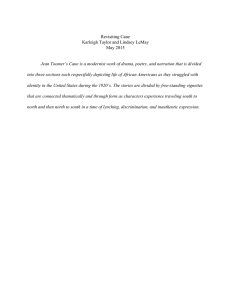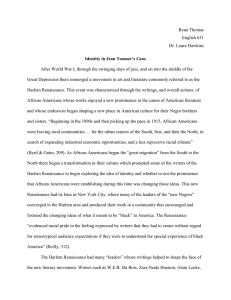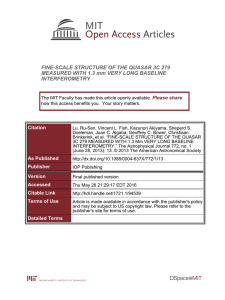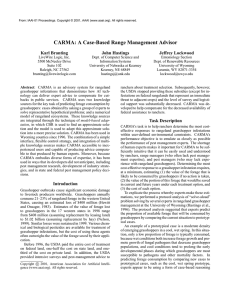02#1 Revision #2 by YL
advertisement
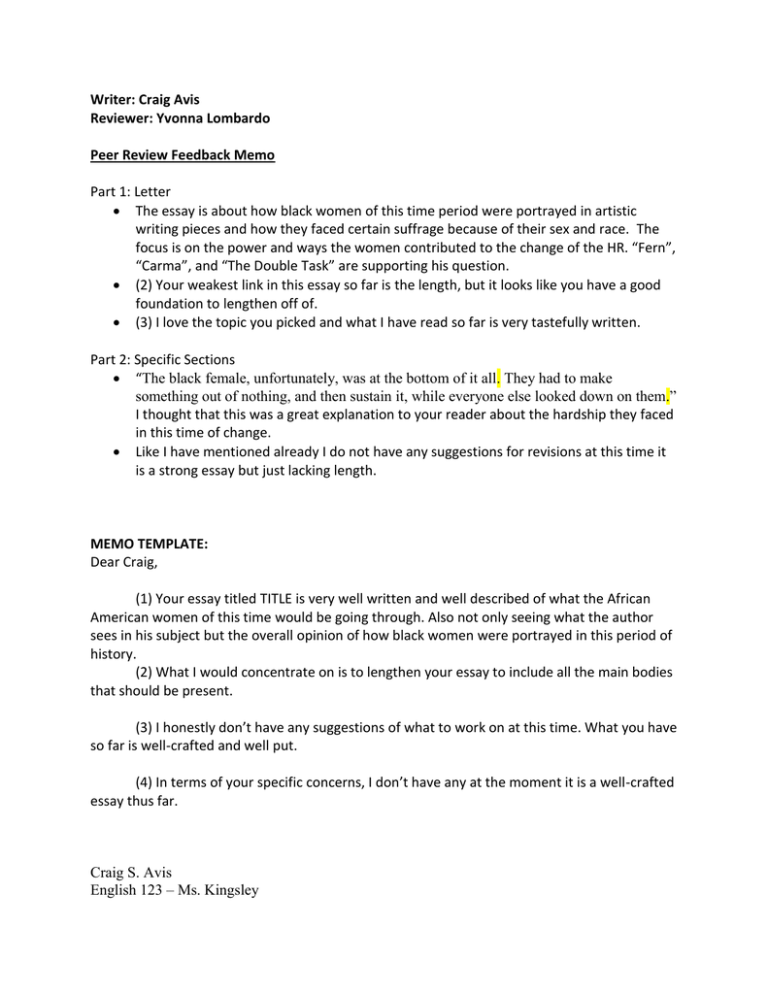
Writer: Craig Avis Reviewer: Yvonna Lombardo Peer Review Feedback Memo Part 1: Letter The essay is about how black women of this time period were portrayed in artistic writing pieces and how they faced certain suffrage because of their sex and race. The focus is on the power and ways the women contributed to the change of the HR. “Fern”, “Carma”, and “The Double Task” are supporting his question. (2) Your weakest link in this essay so far is the length, but it looks like you have a good foundation to lengthen off of. (3) I love the topic you picked and what I have read so far is very tastefully written. Part 2: Specific Sections “The black female, unfortunately, was at the bottom of it all. They had to make something out of nothing, and then sustain it, while everyone else looked down on them.” I thought that this was a great explanation to your reader about the hardship they faced in this time of change. Like I have mentioned already I do not have any suggestions for revisions at this time it is a strong essay but just lacking length. MEMO TEMPLATE: Dear Craig, (1) Your essay titled TITLE is very well written and well described of what the African American women of this time would be going through. Also not only seeing what the author sees in his subject but the overall opinion of how black women were portrayed in this period of history. (2) What I would concentrate on is to lengthen your essay to include all the main bodies that should be present. (3) I honestly don’t have any suggestions of what to work on at this time. What you have so far is well-crafted and well put. (4) In terms of your specific concerns, I don’t have any at the moment it is a well-crafted essay thus far. Craig S. Avis English 123 – Ms. Kingsley Surveying the Harlem Renaissance – Rough Draft #1 February 23, 2015 TITLE How was African-American womanhood and their sexuality artistically portrayed by Elise Johnson McDougald, Jean Toomer, and Anne Spencer in their literature. How does this image give the female figure power, and promote positive growth for the Negro community? In the essay “The Double Task” (1925), by Elise Johnson McDougald, a prominent black journalist, she examines the economic and social relations between four different groups of African-American women, from wealthy to working-class, and their influences to society. She pursued to reject the monumental and replace the embodiment which was the perceived and superficial image of the black woman. McDougald’s focus was to challenge the clichéd portrayal of black women through literature, but also took keen effort on redefining their portrayed sexuality in order to finally give a voice to this doubly oppressed group. McDougald’s audience is primarily directed to anyone willing to listen; however, her aggressive, yet factual, toned conclusion suggests that she is targeting towards ignorant whites. Back in the early part of the twentieth century, the black race was still in the infancy of their emancipation. Around that same time, the Nineteenth Amendment to the U.S. Constitution approved women’s suffrage. While both of these were nationally accepted, not all Americans whereas easily swayed by the masses. This is where African-American woman possibly had it the hardest; not only were they fighting for their freedom as blacks, they were also battling for equality as women. The black female, unfortunately, was at the bottom of it all. They had to make something out of nothing, and then sustain it, while everyone else looked down on them. In Jean Toomer’s short story “Carma” (1923), he uses a fictitious persona to represent, and bring to the forefront, two vital characteristics of a typical, American black woman. The possible outcome is to enlighten the persevering, physical and emotional, strength of womanhood, and to bring forth the raw, underappreciated sexuality of the darker-skinned female. Through this descriptive vignette, he crafts the tale of a strong black woman whose unfaithfulness to her husband, while he is away, leads to a tragic, yet surprising, conclusion. After a petite inaugural poem, Toomer immediately starts his story by introducing the main character, Carma. There are many directions he could have gone with to describe Carma; he chose to focus on her physical strength. She is described as “in overalls, and strong as any man, stands behind the old brown mule, driving the wagon home.” This characteristic is echoed throughout this short piece in order to remind the reader this is an attribute of significance, and is not so easily lost. Even though Toomer assigns this quality to her physique, it is also a reflection of her inner strength given he continually mentions she is alone most of the time and finds refuge on her own, even if it is with other men. Along with her enduring strength, Carma exudes sexuality unmatched to most. Toomer intricately illustrates her not as black, but as a passionate woman. Regardless of her lonesomeness, her strengths are features greatly desired by most men. This zealous sexuality is subtly intertwined throughout this story. Toomer poetically highlights Carma’s femininity by having the narrator observe, “From far away, a sad strong song. Pungent and composite, the smell of farmyard is the fragrance of the woman. She does not sing; her body is a song. She is in the forest, dancing.” Toomer wants the reader to know there is lust for a woman who can persevere, and desire for a woman whose beauty starts from within. Mention “Fern” or “Lady, Lady.” Conclusion The last paragraph of your essay will state what you have discovered about your questions and what still remains unclear or uncertain. You will also indicate what other readings exist or other research you might perform that could be helpful in answering your question. Word Count: 588 Works Cited



